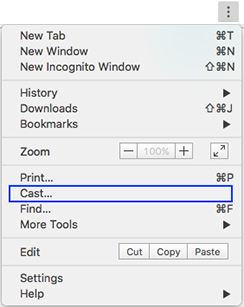Das Web Sender SDK wird in von Google Cast optimierten Webbrowsern auf Mac, Windows, Linux-, ChromeOS- und Android-Geräte Informationen zu nativen mobilen Cast-Apps finden Sie unter Android-Apps und iOS-Apps:
Einrichtung
Web Sender API-Bibliothek zum Projekt hinzufügen
Fügen Sie Ihrer Webseite das folgende Skript hinzu, um die Web Sender API zu verwenden:
<script src="//www.gstatic.com/cv/js/sender/v1/cast_sender.js?loadCastFramework=1"></script>
Anmeldung
Abgesehen von der Registrierung deiner Web Receiver-App und deines Geräts sind keine speziellen Einrichtungsschritte erforderlich. sind für die Verwendung des Web Sender SDK erforderlich.
Um Ihre Web Receiver-App und Ihr Gerät zu registrieren, folgen Sie den Schritten unter Registrierung: Sobald Sie Ihre Antrags-ID haben, können Sie Ihre Web Sender-App entwickeln.
Cast-Schaltflächen testen
Ihre Web Sender-App sollte ein eigenes Cast-Symbol haben. Nutzer können Rufen Sie das Streamen auf, indem Sie wie gezeigt im Kontextmenü Streamen auswählen. hier:

Ihre Web Sender-App sollte beide Fälle verarbeiten.
Chrome-Betaversion
Für Chrome ist außerdem ein öffentlicher Betakanal verfügbar. Neue Versionen von Chrome sind vor der vollständigen Veröffentlichung auf den Betakanal ausgeweitet; der Beta-Kanal ist auch häufiger aktualisiert als die stabile Version. Dadurch erhalten Entwickler (und leidenschaftliche Erstanwender) haben Zugriff auf neue Funktionen und können um sicherzustellen, dass deine Website mit künftigen Versionen von Chrome funktioniert.
So verwenden Sie den öffentlichen Betakanal:
- Betaversion von Chrome installieren
- Wenn Sie Probleme melden möchten, klicken Sie mit der rechten Maustaste auf das Symbol für die Cast-Symbolleiste und wählen Sie „Melden Problem“. Wir können auf die meisten Feedback nicht einzeln antworten, aber wir schätzen es sehr. den Input für den Betakanal.
- Bevor Sie Aktualisierungen an Ihrer Live-Website vornehmen, stellen Sie sicher, dass Sie mit den aktuelle stabile Version von Chrome. Die meisten Besucher Ihrer Website stabile Version von Chrome installiert haben. Falls Sie Betafunktionen benötigen, Nutzer mit der stabilen Version sind betroffen.
